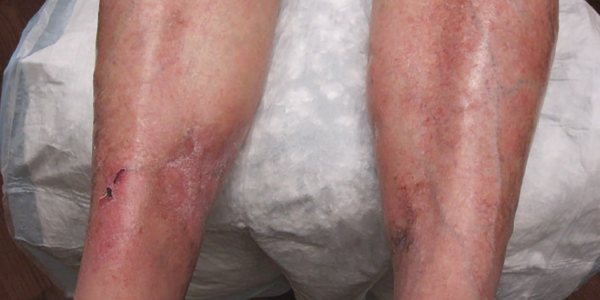Discussion
Due to the nondescript nature of calciphylaxis in the early stages, patients are often diagnosed with advanced disease.2 In our case, diagnosis of calciphylaxis was not officially made until the third sets of biopsies. This may have been due to the early stage of disease at the time of the first two biopsies. Yu et al. found in their study of patients with non-uremic calciphylaxis that roughly half of the patients known to have had warfarin-induced calciphylaxis required multiple biopsies to obtain a definitive diagnosis.5 This demonstrates that obtaining a definitive diagnosis through biopsies can be challenging and require multiple biopsy attempts.
In our case, the patient lacked other etiologies for the skin lesions. Therefore, calciphylaxis was high on our differential, despite initially negative biopsies. Fortunately, the patient was not on many medications, so warfarin was suspected as the most likely culprit. Warfarin was discontinued in favor of an alternative anticoagulant.
Once warfarin was discontinued, the patient showed slow improvement and eventual resolution of her skin lesions. It is likely, therefore, that the cause of the patient’s calciphylaxis was, indeed, the warfarin.
It’s unclear whether warfarin-induced calciphylaxis is clinically different from classic calciphylaxis. Yu et al. assert warfarin-
induced calciphylaxis is distinct in pathogenesis, course of disease and outcome. The authors noted that of the 18 patients studied, the location of the rash was below the knee in 12 of the 18 patients, and 15 of the 18 cases achieved full recovery.5 This is markedly different from the overall prognosis for calciphylaxis, in general, which is reported to have over a 50% one-year mortality rate.6 Similar to cases in this study, our patient presented with lesions on both lower extremities below the knee and achieved a full recovery with some minor residual scarring (see Figure 5).

Figure 5. Healing lesions on both legs.
Conclusion
This case highlights the importance of keeping warfarin-induced calciphylaxis on the differential when a patient presents with signs and symptoms of a medium vessel vasculitis and concurrent warfarin use. Moreover, this case also demonstrates that clinicians should include calciphylaxis in the differential even if initial biopsies fail to initially demonstrate characteristic features.
 Marie V. Dardeno, DO, is third-year resident in the Maine-Dartmouth Family Medicine Residency Program, Augusta.
Marie V. Dardeno, DO, is third-year resident in the Maine-Dartmouth Family Medicine Residency Program, Augusta.
 Joshua D. Sparling, MD, precepts family practice residents in the Maine-Dartmouth Family Residency Program, Augusta, and sees a full panel of dermatology patients in central Maine. He served as an Army dermatologist for 13 years.
Joshua D. Sparling, MD, precepts family practice residents in the Maine-Dartmouth Family Residency Program, Augusta, and sees a full panel of dermatology patients in central Maine. He served as an Army dermatologist for 13 years.


